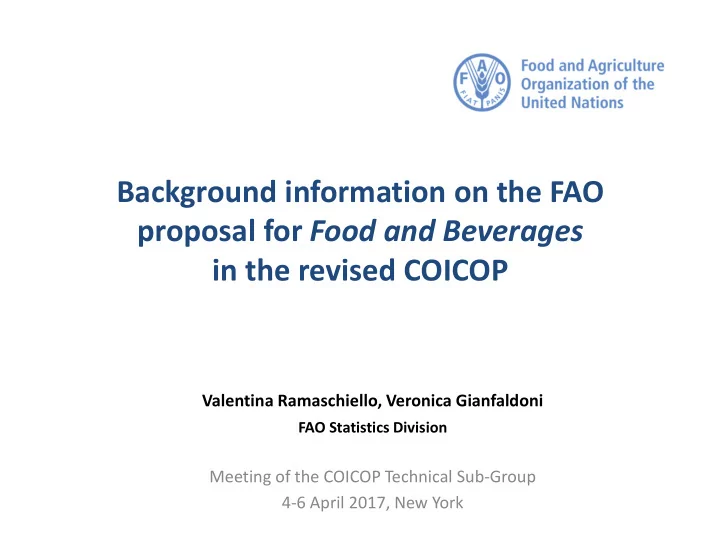

Background information on the FAO proposal for Food and Beverages in the revised COICOP Valentina Ramaschiello, Veronica Gianfaldoni FAO Statistics Division Meeting of the COICOP Technical Sub-Group 4-6 April 2017, New York
Food statistics Food is vital for human surviving besides economic statistics data on food expenditure are widely used to monitor food insecurity HHS data: • critical tool for nutritional at FAO and in many other international and national organizations • used in FAO to integrate the FBS data, the FAO key too to estimate world’s food supply
FOOD consumption kCal, proteins, fat an example of FBS intake per capita 3
need for: • detail • link the production with the consumption side
World’s total expenditure… 39% food and beverages 11% housing 9% transport 7% clothing and footwear 6,5% health and personal care 5% ICT 5% energy 4% education 1% financial services 12% other (Source: WB data)
World’s total expenditure… 39% food and beverages = + housing + clothing and footwear + health and personal care altoghether + ICT + energy + education + financial services
poor people are those who spend the most on food Disaggregating by population segments, consumption on food and beverages ranges from 21% in the higher segment to 54% in the lowest one
the expenditure for food and beverages is the highest in poorest countries and regions South Asia 47 55 % Sub-Saharan Africa 44 61% Middle East & North Africa 43 54% Eastern Europe and Central Asia 40 58% East Asia and Pacific 38 51% Latin America and the Caribbean 27 41% expenditure on food and beverages exceeds 50% in 40 developing countries and exceeds 70% in some cases
Analysis results 58 countries in five regions 80 HHS surveys including information on % of expenditure and contribution to dietary energy consumption 3 12.000 food items 10 20 AFRICA ASIA & PACIFIC CENTRAL ASIA 8 LATIN AMERICA NEAR EAST & NORTH AFRICA 17 Central Asia includes three EU countries
Number of items in each list 150 items on average per list 52 / 80 lists (65%) with more than 100 items: • 9 lists < 50 items • 19 lists between 51 - 99 items • 22 lists between 100 - 149 items • 24 lists between 150 - 299 items • 6 lists > 300 items
Number of items in each list 600 500 400 300 200 100 0
Households’ top expenditure We selected the top expenditure in each survey: Rice Maize flour Bread Meat (cattle, chicken) Milk Tortillas de mais Millet Wheat flour Meat (goat, pig) Cooking bananas Sorghum Maize Crustaceans Fish smoked 0 0 0 0 Meat (dried, salted, smoked) 6 5 Sweet potatoes Tomatoes Sugar rice, other raw cereals, bread fish and meat 18 milk 52 other
01.1.1.1 Raw cereals Wheat Rice Sorghum Barley Millet Quinoa Maize N. of surveys 37 81 23 7 28 5 52 Max. expenditure % 16 38 11 2 23 2 11 Max. energy contribution % 48 76 26 3 47 6 20
01.1.5.1 Edible vegetable oils Sunflower-seed Palm oil Olive oil Soya bean oil Groundnut oil & safflower-seed oil N. of surveys 12 14 12 7 15 Max. expenditure % 3% 6% 0% 4% 4% Max. energy contribution % 13% 19% 0% 7% 9%
01.1.7.7 Pulses, dry Broad & horse Chick Cow Bambara Beans Lentils Peas Pigeon peas beans peas peas beans N. of surveys 49 6 10 15 23 10 2 2 Max. expenditure % 6% 2% 1% 2% 1% 1% 1% 0% Max. energy contribution % 8% 2% 1% 1% 1% 1% 2% 0%
01.1.7.8 Roots and tubers, plantains and cooking bananas Plantains/ Potatoes Cassava Sweet Potatoes Yam Taro Yautia Cooking Bananas N. of surveys 62 43 34 21 12 5 20 Max. expenditure % 5% 8% 13% 5% 4% 2% 7% Max. energy contribution % 4% 23% 21% 8% 2% 1% 4%
01.1.7.1-.5 Vegetables more often reported > 50 surveys Tomatoes, Onions, Cauliflower-Cabbage, Carrot, Cucumber Between 10 – 49 surveys Eggplant, Chilies, Garlic, Beans, Green pepper, Pumpkin, Lettuce, Okra, Cauliflower, Squash, Peas Green, Radish, Mushroom, Spinach, Beet, Broccoli Between 3-9 surveys Gourd, Turnips, Celery, String beans, Green maize, Pickle, Pumpkin, Gourd, Leeks, Artichoke, Lettuce, Chard
01.1.6.1-.5 Fruits more often reported > 50 surveys Banana, Apple, Oranges, Papaya, Mangoes Between 10 – 49 surveys Pineapple, Lemon, Watermelon, Melon, Avocado, Guava, Pears, Grapes, Plum, Jack, fruit, Peaches, Dates, Mandarin, Plantain, Grapefruit, Strawberry, Pomegranate, Apricot, Lime, Raisin Between 3-9 surveys Cherries, Fig, Passion fruit, Blackberry, Kiwi, Tangerin, Cactus fruit, Litchies, Tamarind, Durian, Longan, Pomelo, Sour cherry, Custard apple, Mangosteen, Mulberries, Citrus fruits, Stone fruits
Vegetables & Fruit In addition: about 150 vegetables and fruits reported in < 9 surveys more than 50 local vegetables and fruit
List of reporting countries Afghanistan Egypt Ethiopia Albania Gabon Armenia Gambia Azerbaijan Georgia Bangladesh Ghana Bolivia Guatemala Brazil Haiti Hungary Bulgaria India Burkinafaso Indonesia Cambodia Iraq Cape verde Kazakhstan Chad Kenya Congo demrep Laos Coted'ivoire Liberia Malawi Ecuador
Recommend
More recommend